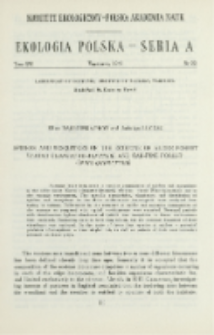- Search in all Repository
- Literature and maps
- Archeology
- Mills database
- Natural sciences
Advanced search
Advanced search
Advanced search
Advanced search
Advanced search

Object
Title: Spiders and mosquitoes of the ecotone of alder forest (Carici elongatae-Alnetum) and oak-pine forest (Pino-Quercetum)
Subtitle:
Pająki i komary ekotonu lasu olszowego (Carici elongatae-Alnetum) i boru mieszanego (Pino-Quercetum)
Contributor:
Polska Akademia Nauk. Komitet Ekologiczny
Publisher:
Place of publishing:
Description:
Strony 461-483 : ilustracje ; 24 cm ; Bibliografia na stronach 481-482 ; Streszczenie w języku polskim
Type of object:
Abstract:
Attempts have been made to analyze communities of spiders and mosquitoes in the alder forest (Carici elongatae·Alnetum), oak-pine forest (Pino-Qucrcetum), and in the ecotone environment. The specific composition, abundance, and distribution of spiders and mosquitoes in the three environments investigated were analyzed from spring to autumn. Differences in the structure of spider and mosquito communities of the ecotone as compared with typical environments were recorded. Seasonal periods with simultaneous highest abundance of spiders and mosquitoes in these environments were analyzed. Dominating species were singled out, and the seasonal dynamics of their abundance was analyzed. On the basis of these data species of spiders – potential predators of mosquitoes – were singled out, as well as periods of their most intensive pressure on those preys
References:
1. Arnoldi, W.K. 1957 - O teorii areala v svjazi s ekologej i proischozdeniem vidovych populacii - Zool. Z. 26: 1609-1629.
2. Barick, F. B. 1950 - The edge effect of the lesser vegetation of certain Adirondack forest types with particular reference to deer and grouse - Roosevelt Wildl. Bull. 9: l-146.
3. Beecher, W. 1942 - Nesting birds and the vegetation substrate - Chicago.
4. Cameron, A. E. 1917 - The insect association of a local environmental complex in the district of Holmes Chapel, Cheshire - Trans. roy. Soc. Edinburg, 52: 37-78.
5. Dąbrowska-Prot, E. 1959 - Aktywność komarów i czynniki ją regulujące - Ekol. Pol. A, 7: 221-254.
6. Dąbrowska-Prot, E. 1961 - Activity as an indication of the distribution of mosquitoes - Bull. Acad. Pol. Sci. Cl. II, 9: 485-490.
7. Dąbrowska-Prot, E. 1962 - Reactions of some mosquito species to microclimatic factors - Bull. Acad. Pol. Sci. Cl. II, 10: 531-535.
8. Dąbrowska-Prot, E., Łuczak, J., Tarwid, K. (in press) - The role of prey and predator density in the process of mosquito reduction by spiders in field experiments - Ekol. Pol. A.
9. Johnston, D.W., Odum, E.P. 1956 - Breeding bird populations in relation to plant succession on the Piedmont of Georgia - Ecology, 37: 50-62.
10. Laird, M. 1947 - Some natural enemies of mosquitoes in the vicinity of Palmalmal, New Britain - Trans. roy. Soc. N.Z. 76: 453-476.
11. Łuczak., J. 1958 - O metodyce badania pająków runa lasu sosnowego - Ekol. Pol. B, 4: 283-292.
12. Łuczak, J. 1959 - The community of spiders of the ground flora of pine forest - Ekol. Pol. A, 7: 285-315.
13. Łuczak., J., Dąbrowska-Prot E. 1966 - Experimental studies on the reduction of the abundance of mosquitoes by spiders. I. Intensity of spider predation on mosquitoes - Bull. Acad. Pol. Sci. Cl. II, 14: 315-320.
14. Odum, E.P. 1959 - Fundamentals of ecology - Philadelphia and London, XVII + 546 pp.
Relation:
Volume:
Issue:
Start page:
End page:
Detailed Resource Type:
Format:
Resource Identifier:
Source:
MiIZ PAN, sygn. P.2840 ; click here to follow the link
Language:
Language of abstract:
Rights:
Licencja Creative Commons Uznanie autorstwa 3.0 Polska
Terms of use:
Zasób chroniony prawem autorskim. [CC BY 3.0 PL] Korzystanie dozwolone zgodnie z licencją Creative Commons Uznanie autorstwa 3.0 Polska, której pełne postanowienia dostępne są pod adresem: ; -
Digitizing institution:
Muzeum i Instytut Zoologii Polskiej Akademii Nauk
Original in:
Biblioteka Muzeum i Instytutu Zoologii PAN
Projects co-financed by:
Access:
Object collections:
- Digital Repository of Scientific Institutes > Partners' collections > Museum and Institute of Zoology PAS > Scientific Journals
- Digital Repository of Scientific Institutes > Literature > Journals/Articles
Last modified:
Feb 4, 2025
In our library since:
Apr 17, 2019
Number of object content downloads / hits:
97
All available object's versions:
https://rcin.org.pl./publication/86238
Show description in RDF format:
Show description in RDFa format:
Show description in OAI-PMH format:
Objects Similar
Dąbrowska-Prot, Eliza Łuczak, Jadwiga Tarwid, Kazimierz
Dąbrowska-Prot, Eliza
Dąbrowska-Prot, Eliza
Dąbrowska-Prot, Eliza
Łuczak, Jadwiga
Dąbrowska-Prot, Eliza Łuczak, Jadwiga

 INSTYTUT ARCHEOLOGII I ETNOLOGII POLSKIEJ AKADEMII NAUK
INSTYTUT ARCHEOLOGII I ETNOLOGII POLSKIEJ AKADEMII NAUK
 INSTYTUT BADAŃ LITERACKICH POLSKIEJ AKADEMII NAUK
INSTYTUT BADAŃ LITERACKICH POLSKIEJ AKADEMII NAUK
 INSTYTUT BADAWCZY LEŚNICTWA
INSTYTUT BADAWCZY LEŚNICTWA
 INSTYTUT BIOLOGII DOŚWIADCZALNEJ IM. MARCELEGO NENCKIEGO POLSKIEJ AKADEMII NAUK
INSTYTUT BIOLOGII DOŚWIADCZALNEJ IM. MARCELEGO NENCKIEGO POLSKIEJ AKADEMII NAUK
 INSTYTUT BIOLOGII SSAKÓW POLSKIEJ AKADEMII NAUK
INSTYTUT BIOLOGII SSAKÓW POLSKIEJ AKADEMII NAUK
 INSTYTUT CHEMII FIZYCZNEJ PAN
INSTYTUT CHEMII FIZYCZNEJ PAN
 INSTYTUT CHEMII ORGANICZNEJ PAN
INSTYTUT CHEMII ORGANICZNEJ PAN
 INSTYTUT FILOZOFII I SOCJOLOGII PAN
INSTYTUT FILOZOFII I SOCJOLOGII PAN
 INSTYTUT GEOGRAFII I PRZESTRZENNEGO ZAGOSPODAROWANIA PAN
INSTYTUT GEOGRAFII I PRZESTRZENNEGO ZAGOSPODAROWANIA PAN
 INSTYTUT HISTORII im. TADEUSZA MANTEUFFLA POLSKIEJ AKADEMII NAUK
INSTYTUT HISTORII im. TADEUSZA MANTEUFFLA POLSKIEJ AKADEMII NAUK
 INSTYTUT JĘZYKA POLSKIEGO POLSKIEJ AKADEMII NAUK
INSTYTUT JĘZYKA POLSKIEGO POLSKIEJ AKADEMII NAUK
 INSTYTUT MATEMATYCZNY PAN
INSTYTUT MATEMATYCZNY PAN
 INSTYTUT MEDYCYNY DOŚWIADCZALNEJ I KLINICZNEJ IM.MIROSŁAWA MOSSAKOWSKIEGO POLSKIEJ AKADEMII NAUK
INSTYTUT MEDYCYNY DOŚWIADCZALNEJ I KLINICZNEJ IM.MIROSŁAWA MOSSAKOWSKIEGO POLSKIEJ AKADEMII NAUK
 INSTYTUT PODSTAWOWYCH PROBLEMÓW TECHNIKI PAN
INSTYTUT PODSTAWOWYCH PROBLEMÓW TECHNIKI PAN
 INSTYTUT SLAWISTYKI PAN
INSTYTUT SLAWISTYKI PAN
 SIEĆ BADAWCZA ŁUKASIEWICZ - INSTYTUT TECHNOLOGII MATERIAŁÓW ELEKTRONICZNYCH
SIEĆ BADAWCZA ŁUKASIEWICZ - INSTYTUT TECHNOLOGII MATERIAŁÓW ELEKTRONICZNYCH
 MUZEUM I INSTYTUT ZOOLOGII POLSKIEJ AKADEMII NAUK
MUZEUM I INSTYTUT ZOOLOGII POLSKIEJ AKADEMII NAUK
 INSTYTUT BADAŃ SYSTEMOWYCH PAN
INSTYTUT BADAŃ SYSTEMOWYCH PAN
 INSTYTUT BOTANIKI IM. WŁADYSŁAWA SZAFERA POLSKIEJ AKADEMII NAUK
INSTYTUT BOTANIKI IM. WŁADYSŁAWA SZAFERA POLSKIEJ AKADEMII NAUK


































